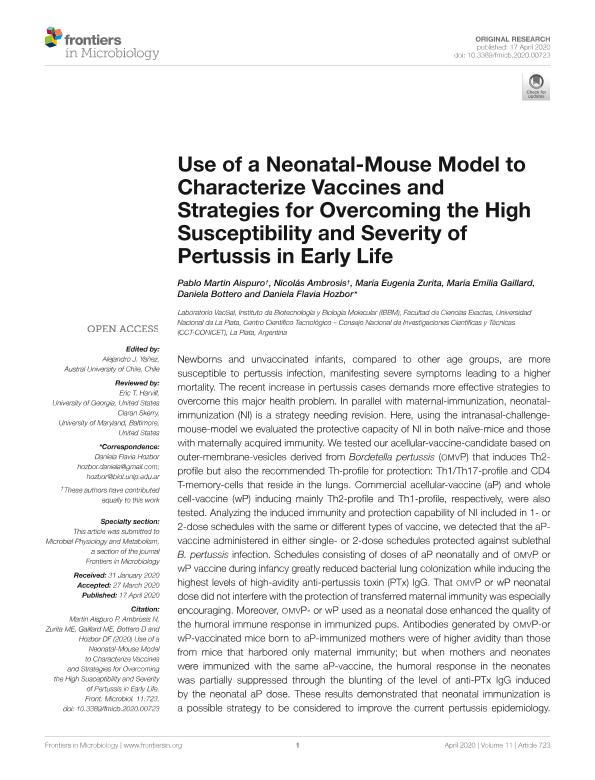Artículo
Use of a Neonatal-Mouse model to characterize vaccines and strategies for overcoming the high susceptibility and severity of pertussis in early life
Martin Aispuro, Pablo ; Ambrosis, Nicolás Martín
; Ambrosis, Nicolás Martín ; Zurita, Maria Eugenia
; Zurita, Maria Eugenia ; Gaillard, María Emilia
; Gaillard, María Emilia ; Bottero, Daniela
; Bottero, Daniela ; Hozbor, Daniela Flavia
; Hozbor, Daniela Flavia
 ; Ambrosis, Nicolás Martín
; Ambrosis, Nicolás Martín ; Zurita, Maria Eugenia
; Zurita, Maria Eugenia ; Gaillard, María Emilia
; Gaillard, María Emilia ; Bottero, Daniela
; Bottero, Daniela ; Hozbor, Daniela Flavia
; Hozbor, Daniela Flavia
Fecha de publicación:
17/04/2020
Editorial:
Frontiers Media
Revista:
Frontiers in Microbiology
ISSN:
1664-302X
Idioma:
Inglés
Tipo de recurso:
Artículo publicado
Clasificación temática:
Resumen
Newborns and unvaccinated infants, compared to other age groups, are more susceptible to pertussis infection, manifesting severe symptoms leading to a higher mortality. The recent increase in pertussis cases demands more effective strategies to overcome this major health problem. In parallel with maternal-immunization, neonatal-immunization (NI) is a strategy needing revision. Here, using the intranasal-challenge-mouse-model we evaluated the protective capacity of NI in both naïve-mice and those with maternally acquired immunity. We tested our acellular-vaccine-candidate based on outer-membrane-vesicles derived from <i>Bordetella pertussis</i> (OMVP) that induces Th2-profile but also the recommended Th-profile for protection: Th1/Th17-profile and CD4 T-memory-cells that reside in the lungs. Commercial acellular-vaccine (aP) and whole cell-vaccine (wP) inducing mainly Th2-profile and Th1-profile, respectively, were also tested. Analyzing the induced immunity and protection capability of NI included in 1- or 2-dose schedules with the same or different types of vaccine, we detected that the aP-vaccine administered in either single- or 2-dose schedules protected against sublethal <i>B. pertussis</i> infection. Schedules consisting of doses of aP neonatally and of OMVP or wP vaccine during infancy greatly reduced bacterial lung colonization while inducing the highest levels of high-avidity anti-pertussis toxin (PTx) IgG. That OMVP or wP neonatal dose did not interfere with the protection of transferred maternal immunity was especially encouraging. Moreover, OMVP- or wP used as a neonatal dose enhanced the quality of the humoral immune response in immunized pups. Antibodies generated by OMVP-or wP-vaccinated mice born to aP-immunized mothers were of higher avidity than those from mice that harbored only maternal immunity; but when mothers and neonates were immunized with the same aP-vaccine, the humoral response in the neonates was partially suppressed through the blunting of the level of anti-PTx IgG induced by the neonatal aP dose. These results demonstrated that neonatal immunization is a possible strategy to be considered to improve the current pertussis epidemiology. For neonates without maternal-immunity, mixed-vaccination schedules that include the aP- and OMVP-vaccines appear to be the most appropriate to induce protection in the pups. For offspring from immune mothers, to avoid blunting-effect, NI should be carried out with vaccines other than those applied during pregnancy.
Archivos asociados
Licencia
Identificadores
Colecciones
Articulos(IBBM)
Articulos de INST.DE BIOTECNOLOGIA Y BIOLOGIA MOLECULAR
Articulos de INST.DE BIOTECNOLOGIA Y BIOLOGIA MOLECULAR
Citación
Martin Aispuro, Pablo; Ambrosis, Nicolás Martín; Zurita, Maria Eugenia; Gaillard, María Emilia; Bottero, Daniela; et al.; Use of a Neonatal-Mouse model to characterize vaccines and strategies for overcoming the high susceptibility and severity of pertussis in early life; Frontiers Media; Frontiers in Microbiology; 11; 723; 17-4-2020; 1-14
Compartir
Altmétricas



